[1] ZUPPINGER. Fraktur der 1. Rippe und Variation der Skapula. Röntgenpraxis. 1935;(7):563.
[2] EYAL A, HERSKOVITS M, LOBERANT N. Benign scapular defects. Rofo. 1989;151(3):375-376.
[3] HERGET GW, OTTO C, KURZ P, et al. Epithelioid osteosarcoma of the scapula. Acta Chir Orthop Traumatol Cech. 2014;81(4):288-291.
[4] SINGAL A, GUPTA T, AGGARWAL A, et al. Osseous deficiencies, pockets, superfluous lateral border thickening in scapula: a rare occurrence. Surg Radiol Anat. 2022;44(4):621-625.
[5] SINGH N, CHAUHAN P, LOH HK, et al. Enigma of scapular foramen and tunnels: an untold story. Surg Radiol Anat. 2018;40(3):327-332.
[6] DONDERS J, PRINS J, KLOEN P, et al. Three-dimensional topography of scapular nutrient foramina. Surg Radiol Anat. 2020;42(8):887-892.
[7] CIGTAY OS, MASCATELLO VJ. Scapular defects: a normal variation. AJR Am J Roentgenol. 1979;132(2):239-241.
[8] 杨思琪,何宁宁,李开平.针刀治疗菱形肌损伤临床研究进展[J].中华中医药学刊,2019,37(9):2301-2304.
[9] 袁淑芬,徐君君,王婷婷,等.温针天宗穴治疗冈上肌腱炎30例疗效观察[J].浙江中医杂志,2015,50 (11):846.
[10] 张琦,孙大伟,陈海鹏.封闭配合小针刀治疗肩胛骨上神经卡压综合征的经验体会[J].新疆中医药,2021,39(2):20-21.
[11] 罗登攀, 黄节, 赵宁.基于肌筋膜触发点的干针疗法治疗颈肩肌筋膜疼痛综合征临床研究[J].新中医,2022,54(5):205-210.
[12] 张树剑,张建兰.什么是针灸传统:历史与比较的视角[J].科技导报,2019,37(15):15-19.
[13] 张鑫,王宗宝,高云胜,等. 小针刀结合浮针疗法治疗菱形肌损伤[J].长春中医药大学学报,2017,33(3):451-452.
[14] 陈跃,吴炳煌,阙庆辉,等.针刀手术治疗劳损性肩背痛症41例[J].福建中医学院学报,2003(5):39-40.
[15] 针刀医学诊疗规范(草案、讨论稿)[J].科学之友(B版),2007(8): 320-352.
[16] 郭长青.从针刀松解法基础研究看中医现代化[J].世界科学技术, 2005,7(S1):98-99.
[17] PATEL N, PATEL M, POUSTINCHIAN B. Dry Needling-Induced Pneumothorax. J Am Osteopath Assoc. 2019;119(1):59-62.
[18] KIM JS, KIM KH, KIM WW. 17 Cases of Acupuncture Related Pneumothorax and Factors Influencing Pneumothorax. Acupunct Electrother Res. 2016;41(2):95-105.
[19] 陈关富.菱形肌损伤行针刀治疗致气胸一例[J].临床误诊误治, 2009,22(12):24.
[20] PATE D, KURSUNOGLU S, RESNICK D, et al. Scapular foramina. Skeletal Radiol. 1985;14(4):270-275.
[21] OGDEN JA, PHILLIPS SB. Radiology of postnatal skeletal development. VII. The scapula. Skeletal Radiol. 1983;9(3):157-169.
[22] TUNCER MC, ORHAN T, HATIPOĞLU ES. Foramen Scapulae Osseum. Dicle Medical Journal / Dicle Tip Dergisi. 2005;32(1):40-42.
[23] BAGOJI IB, HADIMANI GA, BULGOUD RS, et al. Anatomical Variations of the Suprascapular Notch and its Importance in Suprascapular Entrapment Neuropathy. Maedica (Bucur). 2020;15(3):298-304.
[24] 边祥涛.小针刀疗法治疗肩背部筋膜炎的临床研究[D].哈尔滨:黑龙江中医药大学,2005:2-8.
[25] 鲜琦琦.针刺联合手三里、肩痛穴埋线治疗肩背肌筋膜炎的临床疗效观察[D].成都:成都中医药大学,2021:6-15.
[26] 雷德宝,刘金川.冲击波联合激痛点臭氧注射对颈肩肌筋膜疼痛综合征的临床观察[J].中国中医骨伤科杂志,2020,28(6):42-45.
[27] 朱俊琛,王超,马幸福,等.菱形肌损伤的针刀松解与梅花针叩刺疗法的临床疗效观察[J].中国中医骨伤科杂志,2016,24(12):15-18.
[28] 谢敏,吴锦泽,姜玉雯,等.小针刀治疗肩周炎临床疗效Meta分析[J].中国初级卫生保健,2022,36(5):120-123.
[29] 张红梅.天宗穴水针治疗眩晕症58例[J].中医外治杂志,2010, 19(1):39.
[30] 李江舟,赵艳,刘芳.长圆针解结天宗次治疗乳腺增生病86例[J].辽宁中医药大学学报,2008(11):129.
[31] 王淑娟,李江舟,王松子.长圆针解结天宗次治疗乳腺增生病的临床研究[J].辽宁中医杂志,2012,39(11):2265-2267.
[32] 杨晓琼.火针结合电针治疗颈肩背部肌筋膜炎的临床研究[D].广州:广州中医药大学,2011:3-5.
[33] 刘利红.椎针疗法治疗颈肩肌筋膜炎临床疗效的随机对照试验研究[D].南昌:江西中医药大学,2020:7-14.
[34] 冯芳军.双侧冈下肌注射配合手法治疗颈椎病[J].陕西中医学院学报,2002,25(6):28-29.
[35] PARK J, SU MY, KIM YU. Accuracy of suprascapular notch cross-sectional area by MRI in the diagnosis of suprascapular nerve entrapment syndrome - a retrospective pilot study. Korean J Anesthesiol. 2022. doi: 10.4097/kja.22153. Online ahead of print.
[36] PRENAUD C, LOUBEYRE J, SOUBEYRAND M. Decompression of the suprascapular nerve at the suprascapular notch under combined arthroscopic and ultrasound guidance. Sci Rep. 2021;11(1):18906.
[37] YOO YS, JANG SW, KIM YS, et al. Does the Suprascapular Nerve Move within the Suprascapular Notch? Biomechanical Perspective Using the Finite Element Method. Yonsei Med J. 2022;63(7):657-664.
[38] TSIKOURIS G, ANTONOPOULOS I, VASDEKI D, et al. Morphometry and Contents of the Suprascapular Notch with Potential Clinical Implications: A Cadaveric Study. J Brachial Plex Peripher Nerve Inj. 2021;16(1):e31-e36.
[39] AL-REDOUAN A, HUDAK R, NANKA O, et al. The morphological stenosis pattern of the suprascapular notch is revealed yielding higher incidence in the discrete type and elucidating the inevitability of osteoplasty in horizontally oriented stenosis. Knee Surg Sports Traumatol Arthrosc. 2021;29(7):2272-2280.
[40] 贵鹏.肩前穴联合冈下肌MTrP穴位注射治疗冻结肩(急性期)的临床疗效观察[D].长沙:湖南中医药大学,2021:12-16.
[41] 陈墨.MTrPs干针结合常规针刺治疗爱尔兰群众肩周炎的临床研究[D].南京:南京中医药大学,2017:9-21.
[42] WANG HJ, CHEN C, WU LP, et al. Variable morphology of the suprascapular notch: an investigation and quantitative measurements in Chinese population. Clin Anat. 2011;24(1):47-55.
[43] WIJDICKS A, ARMITAGE BM, ANAVIAN J, et al. Vulnerable neurovasculature with a posterior approach to the scapula. Clin Orthop Relat Res. 2009;467(8):2011-2017. |
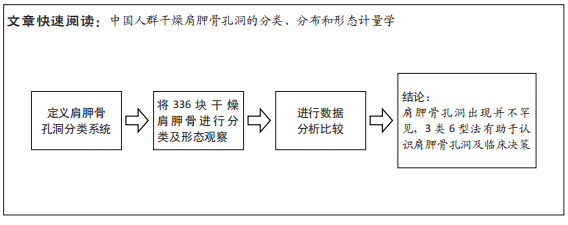
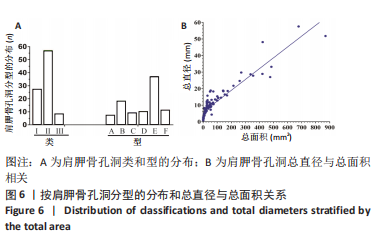
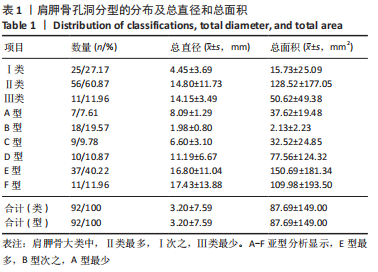

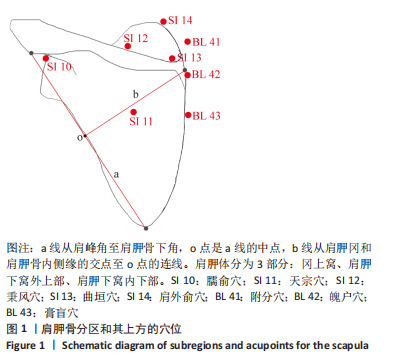 对肩胛骨孔洞的了解无疑有助于区分肩胛骨孔洞生理变异与病理状况,并更安全地进行侵入性治疗操作和肩胛部的手术[4-5,19]。此次实验推测肩胛骨孔洞的分布和形态计量学可能具有一定的规律性,目的是测量和分析中国人群干燥肩胛骨中肩胛骨孔洞的形态计量学,并根据肩胛骨孔洞的分布、形式和发生频率,对肩胛骨孔洞进行分类。
对肩胛骨孔洞的了解无疑有助于区分肩胛骨孔洞生理变异与病理状况,并更安全地进行侵入性治疗操作和肩胛部的手术[4-5,19]。此次实验推测肩胛骨孔洞的分布和形态计量学可能具有一定的规律性,目的是测量和分析中国人群干燥肩胛骨中肩胛骨孔洞的形态计量学,并根据肩胛骨孔洞的分布、形式和发生频率,对肩胛骨孔洞进行分类。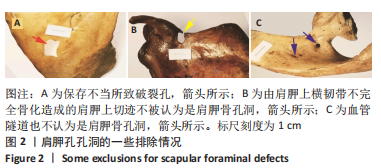
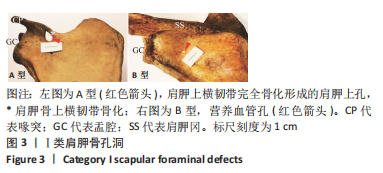
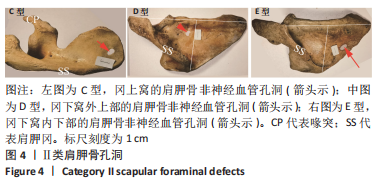
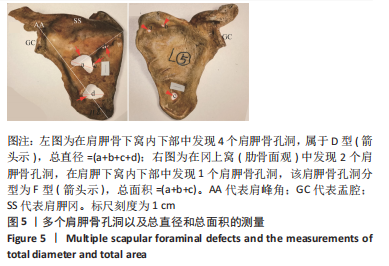
 一些研究包括肩胛骨的血管营养孔,而一些研究排除了血管营养孔;一些研究认为肩胛骨孔洞的边缘是光滑的,有些则认为其边缘是锐利的;有研究排除了退化衰老所致,而一些研究没有明确提出排除[3,5,19]。作者认为有必要提出适合临床需要的肩胛骨孔洞定义,因此将肩胛骨孔洞定义为通过肩胛骨的双皮质骨可见的孔洞,该孔洞在骨发育过程中形成,或由韧带骨化或骨质疏松引起,并且通常肩胛骨孔洞在临床上是良性的和无症状的。肩胛骨孔洞的存在不仅对涉及肩胛骨疾病的诊断具有重要的参考价值,对临床侵入性操作也有非常重要的指导意义。围绕肩胛骨的侵入性操作[24-36],如中医针刺、针刀、干针、局部注射等,在临床上都很常见[23-25],其安全性需要引起足够的重视。
一些研究包括肩胛骨的血管营养孔,而一些研究排除了血管营养孔;一些研究认为肩胛骨孔洞的边缘是光滑的,有些则认为其边缘是锐利的;有研究排除了退化衰老所致,而一些研究没有明确提出排除[3,5,19]。作者认为有必要提出适合临床需要的肩胛骨孔洞定义,因此将肩胛骨孔洞定义为通过肩胛骨的双皮质骨可见的孔洞,该孔洞在骨发育过程中形成,或由韧带骨化或骨质疏松引起,并且通常肩胛骨孔洞在临床上是良性的和无症状的。肩胛骨孔洞的存在不仅对涉及肩胛骨疾病的诊断具有重要的参考价值,对临床侵入性操作也有非常重要的指导意义。围绕肩胛骨的侵入性操作[24-36],如中医针刺、针刀、干针、局部注射等,在临床上都很常见[23-25],其安全性需要引起足够的重视。